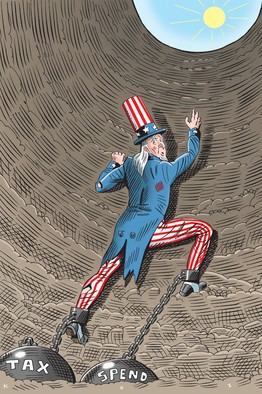The Spending 'Freeze' That Isn't
Since 2008, the ratio of outlays-to-GDP has risen by about 14%.
By
Edward P. Lazear
WSJ.com
In last night's State of the Union address President Obama proposed a three-year "spending freeze" on what amounts to one-sixth of the federal budget. Our biggest entitlement programs, Social Security and Medicare, would be excluded. These changes are optical rather than substantive. Given the spending agenda that is already in place, we can expect to see large increases in the proportion of GDP that is spent by our government for years to come.
Since 2008, the ratio of federal spending-to-GDP has risen by about 14%. From 2008 to 2009 we saw the greatest annual increase in spending in the last 30 years. In the name of stimulating job growth, the share of federal spending is now 24% of the economy, up from 21% in the last year of the Bush administration.
My analysis of data from 1950 to the present shows that periods with high tax-to-GDP ratios exhibit much slower economic growth than lower tax ratio periods. The GDP growth in high tax years (defined as years during which the ratio of tax-to-GDP was above 18%, the 60-year average) was about 1.5 percentage points lower than the growth rate in low-tax years.
High taxes are clearly bad for the U.S. economy. For example, were we to tax above the 18% tax-to-GDP ratio over the next 25 years, GDP per capita in 2035 would be about 50% less than if we were to tax below the 18% ratio. A 50% per capita GDP differential is about as large as the difference between the U.S. and Greece today.
The recent growth in spending has been camouflaged by a focus on deficits. Budgets and proposed legislation, like that on health care, are being judged not by their impact on spending and taxation, but by their projected effect on the deficit. Equal increases in spending and taxes reduce economic growth, even if they do not alter the deficit.
So the rhetoric surrounding the health-care bills misses this point. Were they to pass, it would mean more spending, more taxes and less growth. Both the White House and Congress have discussed fiscal responsibility in terms of the bills' effect on the deficit, not the amount of spending.
The health legislation that looked likely until Massachusetts voted last week included about $1 trillion in new spending, $500 billion in promised Medicare cuts, and slightly more than $500 billion in increased taxes. If the Medicare cuts were to materialize, then the bill would reduce the deficit because tax increases exceed net new spending.
But even if the Medicare cuts were realized, the policy would contribute to the growing size of federal spending and the budget, which, when financed, is the major impediment to economic growth. Arguments over whether the legislation would increase or decrease the deficit or whether it would bend the "cost curve" down or raise it are secondary as far as economic growth is concerned. The largest impact comes from levying over $500 billion of new taxes to pay for the increased spending.
Despite all the talk about deficits, the irony is that we are in little danger of eliminating or reducing the federal deficit. Mr. Obama's target is to lower the deficit to 4% of GDP by 2013. That is twice the level of the Bush deficit in the average year and larger than any Bush-year deficit. During President George W. Bush's term, the ratio of federal spending to GDP averaged 20%. Mr. Obama's budget aspires to reduce the spending ratio to 23% by 2013 from 24% today.
It is true that Mr. Obama inherited much from his predecessor, as the president and his surrogates are wont to remind us. There is no doubt that when the new team came in, the economy was in a deep recession and job losses were large. He inherited an unemployment rate that was over 7%. It now stands at 10%. The job growth that was the promised outcome of the $787 billion stimulus bill has not materialized. And when job growth returns and unemployment falls, it will owe little to the stimulus.
Consider the legacies Mr. Obama will leave his successor. He grew the deficit that he inherited. He grew the government spending ratio that he inherited. And he has already promised to repeal the low tax rates that he inherited. At this point, the question is how much and what form the tax increases will take. Part of the Bush legacy includes low personal tax rates, an average ratio of taxes-to-GDP of about 18%, low rates on capital gains, and a period of low estate taxes.
It will be virtually impossible for Mr. Obama to keep his promise not to raise taxes on the middle class while paying for an enormous increase in spending. Given the planned spending levels, taxes will have to rise substantially to get to the target 4% deficit figure that the White House wants.
Medicare tax increases on wages and dividends, and new levies on businesses, are already being discussed. In the longer run, we may see a push to introduce a federal value-added-tax.
Let us pay close attention to the president's message. But let us not be confused by promises of jobs, coupled with fiscally responsible sounding language that masks the underlying irresponsibility of budget decisions. Proposals that increase taxes and spending, even if they do not increase the deficit, will place a substantial burden on our recovering economy and on future economic growth.
Mr. Lazear, chairman of the President's Council of Economic Advisers from
2006-2009, is a professor at Stanford University's Graduate School of Business
and a Hoover Institution fellow.
